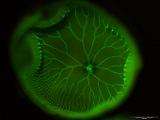New insights into diabetic blindness

(PhysOrg.com) -- New research by University College Dublin scientists indicates that treatment of diabetic blindness should look at protecting the neurons responsible for colour vision in the eye and not just targeting the blood vessels as is currently the practice.
The research team led by Conway Fellow, Dr Breandán Kennedy from the School of Biomolecular & Biomedical Science recently published their findings in the journal Disease Models & Mechanisms.
Nearly 2.5 million people worldwide are blind due to a secondary complication of diabetes called diabetic retinopathy. This disorder activates the growth of new leaky blood vessels in the eye and is responsible for the death of photoreceptors, the neurons that send visual messages to our brain.
Until now, scientists were unclear if the changes to vessels and neurons occurred independently of one other. Questions were also asked about which type of retinal neuron is most likely to die as a result of the raised glucose levels seen in diabetes.
Dr Kennedy and his team found that new blood vessels and the neuronal cell death in diabetic retinopathy can arise independently of each other. In addition, they identified that cone photoreceptor neurons, those involved in colour vision and which we use to see during daylight are most affected by the high glucose levels.
The research team made their observations by successfully generating a zebrafish model of diabetes. The eyes of these small, tropical freshwater fish are very similar in design to humans, making it a useful species to study blindness. The high levels of glucose typically seen in people suffering with diabetes were stimulated in zebrafish and the fish studied to see whether they exhibited known diabetic symptoms.
This novel model of the disease resembles the early stages of diabetic retinopathy in humans. It is an exciting development for the Kennedy group who now hope to further extend their research and establish a model of late stage diabetic disease.
Current treatment for diabetic retinopathy sufferers tries to prevent the growth of new blood vessels in the late stage of the disease. There are associated side effects and the treatments halt but do not cure the disease. This research suggests a need to also protect the neurons before the disease progresses to the late stage.
Commenting on the research, Dr Kennedy said, “By establishing a robust model for early and late stage diabetic retinopathy, we would hope to better understand the progression of the disease and pave the way for identifying new drug targets for its successful treatment”.
















